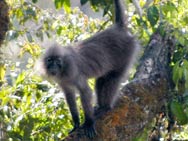New Monkey Species With Goose-Like Call Discovered
Two Separate Teams of Scientists Stumble Across the Strange New Animal in Tanzania
By AMANDA ONION
- When a team of scientists first heard hunters from Tanzania's Wanyakyusa tribe talk about a quiet, black-faced monkey that hung out in high elevations, they weren't sure if it was real or a "spirit" animal from the tribe's oral tradition.
"Sometimes the difference between real and spiritual animals is not clear-cut when you speak with the Wanyakyusa. So we went into the forest with one of the hunters," said Tim Davenport, director of Wildlife Conservation Society's Southern Highlands Conservation Program in southwestern Tanzania. "That was the only way we could determine it was real in the way we understand the term 'real' to be."
It turns out not only was the monkey real, it was also a species completely new to scientists.
The 3-foot-long tree-living animal with brown fur, a white belly and a punk-like crest of hair on its head has been called "kipunji" locally, and now has a scientific name: Lophocebus kupunji, or the highland mangabey. The animal may have eluded researchers for so long because it lives in high altitudes in the treetops and is generally a very quiet monkey.
When it does make a sound, however, it's a strange one. Davenport dubbed the male highland monkey's territorial call the "honk-bark."
"The honk part of the call sounds like a goose," Davenport explained, "and the bark part sounds like a dog. It's very unique for a monkey." 
Shared Discovery
By sheer coincidence, the new species was almost simultaneously, but independently discovered by another group of scientists working 230 miles away in Tanzania's Ndundulu Forest Reserve.
It wasn't until members from each group were talking at a bar in Tanzania that they realized they had the same big find on their hands.
"My colleague, Carolyn Ehardt, told her friend at the bar that we had made an amazing discovery," recalled Trevor Jones, an anthropologist from the University of Georgia in Athens whose team had come across the same monkey just months after Davenport's group. "Her friend said, 'It wouldn't be a primate, would it?' She said, 'Yes!'"
While Davenport's group had specifically sought out the unusual monkey described by locals, Jones and his colleagues came across the new species by chance. Jones was searching for a different monkey -- the Sanje mangabey, which features a pink face and gray fur -- when he saw the black-faced species flit across the view of his binoculars.
"I knew instantly that it was something different," Jones said. "It struck me straight away -- the all-black face and its crazy, upright hair."
New species of small animals like insects turn up on a regular basis, but finding a new monkey species is an unusual event. The last time a new monkey species was discovered in Africa was more than 20 years ago.
Jones points out, however, that in recent years there has been a "bizarre rush" of new monkey finds, including a new macaque monkey found in India last December and two cat-sized monkeys found in Brazil three years ago.
The finding of the highland mangabey has big implications for those working on charting the evolution of this group.
Mangabeys belong to two main groups. One kind sticks mainly to forest floors and is related to mandrills. The other, which includes this new species, lives in trees and is closely related to baboons. This find may help scientists more accurately trace the evolution of mangabeys from baboons and mandrills.
"Mangabey taxonomy is a real mess right now," said Jones. "This find might help us clarify some of that."
New and Fragile
To ensure future study of the new species, however, both teams of biologists emphasize that the animal needs to be protected.
Right now, scientists place population estimates for the monkey at 500 to 1,000 animals, which would classify the species as critically endangered. The animals have a number of factors working against their survival. Local people occasionally hunt the animal and, most gravely, the Southern Highlands forest where Davenport's group discovered the monkeys has been severely damaged by extensive logging.
"From our point of view, finding this new species is the start of a process, not the end of one," said Davenport. "Now it's our responsibility to ensure its survival."






